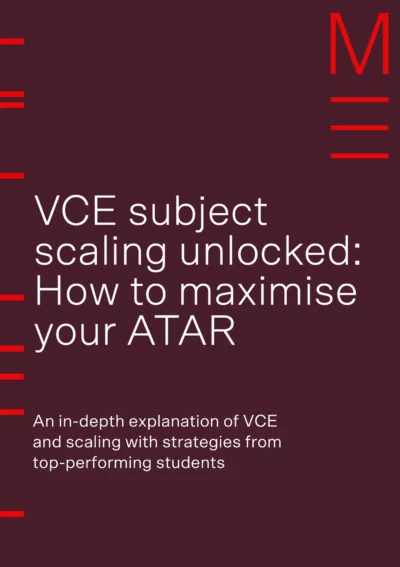Welcome to Matrix Education
To ensure we are showing you the most relevant content, please select your location below.
Select a year to see courses
Learn online or on-campus during the term or school holidays
Learn online or on-campus during the term or school holidays
Learn online or on-campus during the term or school holidays
Learn online or on-campus during the term or school holidays
Learn online or on-campus during the term or school holidays
Learn online or on-campus during the term or school holidays
Learn online or on-campus during the term or school holidays
Get HSC exam ready in just a week
Select a year to see available courses
Science guides to help you get ahead
Science guides to help you get ahead
Looking for clear and comprehensive solutions to the 2024 VCE Specialist Maths Exam Paper 1? We've got you covered!

Join 75,893 students who already have a head start.
"*" indicates required fields
In this article, we reveal 2024 VCE Specialist Maths Exam Paper 1 Solutions, complete with full explanations written by the Matrix Maths Team.

Have you seen the 2024 VCE Specialist maths exam paper yet? For reference, you can find it here.
Get VCE ready with this comprehensive study planner. Fill out your details below to get this resource emailed to you. "*" indicates required fields
Free VCE Study Planning Kit Download

Free VCE Study Planning Kit Download
(a).
We simply check that \(f(-\frac{2i}{3})=0\). Indeed,
\begin{align*}
f\bigg(-\frac{2i}{3}\bigg)&=3\bigg(-\frac{2i}{3}\bigg)^{3}+2i\bigg(-\frac{2i}{3}\bigg)^{2}+3\bigg(-\frac{2i}{3}\bigg)+2i
\\&=\frac{8}{9}i-\frac{8}{9}i-2i+2i
\\&=0.
\end{align*}
(b).
Polynomial long division gives that
\[
f(z)=(3z+2i)(z+i)(z-i)
\]
and so \(f(z)=0\) has solutions \(z=-\frac{2}{3}i,i,-i\).
(c).
Suppose that \(x\) is an odd integer. That is, \(x=2k+1\) for some \(k\in\mathbb{Z}\). Then
\begin{align*}
2x^{2}-3x-7&=2(2k+1)^{2}-3(2k+1)-7
\\&=8k^{2}+2k-8
\\&=2(4k^{2}+k-4)
\end{align*}
which is even since \(4k^{2}+k-4\in\mathbb{Z}\).
(a).
We simply check that
\[
1+\frac{-4}{x+1}+\frac{4}{(x+1)^{2}}=\frac{x^{2}-2x+1}{(x+1)^{2}}=\frac{(x-1)^{2}}{(x+1)^{2}}.
\]
(b).
The derivative of \(f(x)\) is given by
\[
f^{\prime}(x)=\frac{4}{(x+1)^{2}}-\frac{8}{(x+1)^{3}}
\]
and so
\[
f^{\prime}(x)=0\iff \frac{4}{(x+1)^{2}}-\frac{8}{(x+1)^{3}}=0\iff x=1.
\]
Since \(f(1)=0\) this means that \(f\) has a stationary point at the point \((1,0)\). Since there is only one stationary point and the question says that the graph has one turning point, this must also be the turning point.
(c).
(a).
We compute that \(|\vec{a}|=3\sqrt{2},|\vec{b}|=3\) and \(\vec{a}\cdot\vec{b}=-9\).
Hence
\[
\cos\theta=\frac{\vec{a}\cdot\vec{b}}{|\vec{a}||\vec{b}|}=-\frac{1}{\sqrt{2}}
\]
and so \(\theta=\frac{3\pi}{4}\).
(b).
Note that \(|\vec{c}|=(n^{2}+5)^{1/2}\) and that \(\vec{a}\cdot\vec{c}=9\).
Thus
\[
|\vec{a}\times\vec{c}|=|\vec{a}||\vec{c}||\sin\theta|=3(n^{2}+5)^{1/2}.
\]
Hence we want
\[
3(n^{2}+5)^{1/2}=9
\]
which rearranges to give \(n=\pm 4\).
The volume of the solid of revolution is given by
\begin{align*}
V&=\pi\int_{1}^{\frac{k}{2}}k-\frac{1}{x^{2}}dx
\\&=\pi\bigg[kx+\frac{1}{x}\bigg]_{1}^{\frac{k}{2}}
\\&=\pi\bigg(\frac{k^{2}}{2}+\frac{2}{k}-k-1\bigg).
\end{align*}
Hence
\[
\pi\bigg(\frac{k^{2}}{2}+\frac{2}{k}-k-1\bigg)=\frac{7\pi}{2}
\]
which rearranges to give
\[
k^{3}-2k^{2}-9k+4=0.
\]
(a).
The expected value is given by
\[
E(W_{1}+W_{2}+W_{3})=E(W_{1})+E(W_{2})+E(W_{3})=1+1.5+2=4.5
\]
and the variance is given by (recall that variance is additive over independent random variables)
\[
Var(W_{1}+W_{2}+W_{3})=Var(W_{1})+Var(W_{2})+Var(W_{3})=0.3^{2}+0.4^{2}+0.5^{2}=0.5.
\]
(b).
The variance of the cost to produce one weed trimmer is given by (again, recall that variance is additive over independent random variables)
\[
Var(10W_{1}+20W_{2}+15W_{3})=10^{2}Var(W_{1})+20^{2}Var(W_{2})+15^{2}Var(W_{3})=\frac{517}{4}\$/\text{h}.
\]
(c).
We want to find \(Pr(W_{2}<W_{1})=Pr(W_{2}-W_{1}<0)\). To this end, note that \(W_{2}-W_{1}\) is also normally distributed with \(E(W_{2}-W_{1})=E(W_{2})-E(W_{1})=0.5\) and \(Var(W_{2}-W_{1})=Var(W_{2})+Var(W_{1})=0.25\).
Hence
\[
Pr(W_{2}<W_{1})=Pr\bigg(Z<\frac{0-0.5}{\sqrt{0.25}}\bigg)=Pr(Z<-1)=0.16.
\]
We rearrange the differential equation to
\(
\begin{align*}
2y \, dy = \frac{-x}{\sqrt{x^{2} + 1}} \, dx &\Rightarrow \int 2y \, dy = \int \frac{-x}{\sqrt{x^{2} + 1}} \, dx, \\
&\Rightarrow y^{2} = -\sqrt{x^{2} + 1} + C.
\end{align*}
\)
The initial conditions \(y(0)=-2\) imply that \(C=5\).
Hence the solution is given by
\(
y^{2} = 5 – \sqrt{x^{2} + 1} \Rightarrow y = -\sqrt{5 – \sqrt{x^{2} + 1}}.
\)
where we took the negative square root since \(y(0)\) is negative.
(a).
Differentiating both sides with respect to \(x\) gives that
\[
2xy^{2}+2x^{2}y\frac{dy}{dx}+y+x\frac{dy}{dx}=0
\]
which rearranges to give
\[
\frac{dy}{dx}=\frac{-y(2xy+1)}{x(2xy+1)}=-\frac{y}{x}
\]
provided that \(2xy\neq -1\).
(b).
We want \(-\frac{y}{x}=-1\) which rearranges to \(y=x\).
Hence
\(
x^{4} + x^{2} = 2 \Rightarrow (x^{2} + 2)(x^{2} – 1) = 0 \Rightarrow x = \pm 1.
\)
Since \(y=x\) this means that \(y=\pm1\). That is, the points \((1,1)\) and \((-1,-1)\) have tangents with a gradient of \(-1\).
(a).
When \(x=0\) we find that
\[
v^{2}=1600+\frac{672}{\pi}\cos^{-1}(0)=1936.
\]
Note that the speed detection device will be activated if the speed of the car is at least \(1.1\times 40=44 \text{ km h}^{-1}\). Since \(44^{2}=1936\) this means that the speed detection device will be activated.
(b).
Here we use the fact that the acceleration is given by \(a=\frac{d}{dx}(\frac{1}{2}v^{2})\).
Hence
\[
a=\frac{d}{dx}\bigg(\frac{1}{2}v^{2}\bigg)=\frac{d}{dx}\bigg(800+\frac{336}{\pi}\cos^{-1}(x)\bigg)=-\frac{336}{\pi\sqrt{400-x^{2}}}.
\]
When \(x=12\) this is
\[
a=-\frac{336}{\pi\sqrt{400-12^{2}}}=-\frac{21}{\pi}.
\]
First we compute the normal vector that is perpendicular to both lines. This is given by
\[
\vec{n}=\begin{pmatrix} 1 \\ 2 \\ 1 \end{pmatrix}\times\begin{pmatrix} -1 \\ 3 \\ 2 \end{pmatrix}=\begin{pmatrix} 1 \\ -3 \\ 5 \end{pmatrix}.
\]
Next compute that \(|\vec{n}|=\sqrt{35}\) so that a unit normal vector is given by
\[
\hat{\vec{n}}=\frac{1}{\sqrt{35}}\begin{pmatrix} 1 \\ -3 \\ 5 \end{pmatrix}.
\]
We then put \(\vec{v}\) to be the difference in starting points of the two lines. That is,
\[
\vec{v}=\begin{pmatrix} 2 \\ 0 \\ -1 \end{pmatrix}-\begin{pmatrix} 1 \\ 0 \\ m \end{pmatrix}=\begin{pmatrix} 1 \\ 0 \\ -1-m \end{pmatrix}.
\]
The shortest distance between the two lines is then given by the length of the projection of \(\vec{v}\) onto \(\hat{\vec{n}}\). That is, the shortest distance between the two lines is
\[
|\text{proj}_{\hat{\vec{n}}}(\vec{v})|=|\vec{v}\cdot\hat{\vec{n}}|=\frac{1}{\sqrt{35}}|1-5(1+m)|.
\]
Hence we want
\[
\frac{1}{\sqrt{35}}|1-5(1+m)|=\frac{14}{\sqrt{35}}
\]
which rearranges to give
\[
m=2,-\frac{18}{5}.
\]
Want to know how Specialist Maths can affect your ATAR?
An in-depth explanation of VCE and scaling with strategies from top-performing students. Fill out your details below to get this resource emailed to you. "*" indicates required fields
Free 2025 VCE ATAR & Scaling Guide Download

Free 2025 VCE ATAR & Scaling Guide Download
Written by Oak Ukrit
Oak is the Head of Mathematics at Matrix Education and has been teaching for over 12 years and has been helping students at Matrix since 2016. He has 1st class honours in Aeronautical Engineering from UNSW where he taught for over 4 years while he was undertaking a PhD. When not plane spotting he enjoys landscape photography.© Matrix Education and www.matrix.edu.au, 2023. Unauthorised use and/or duplication of this material without express and written permission from this site’s author and/or owner is strictly prohibited. Excerpts and links may be used, provided that full and clear credit is given to Matrix Education and www.matrix.edu.au with appropriate and specific direction to the original content.